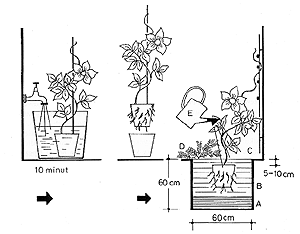Planting & Maintenance
Clematis grown in containers can be planted throughout the season from April to mid-November. The vines selected for planting should be previously cultivated in containers and ought to have a well-developed system of roots, as well as hardened stems at the base.
Before planting it is advisable to immerse the containers in water (e.g. in a bucket) for about 10 minutes so that the soil can absorb the water. Remove the plant from the pot, taking care not to smash the rootball. Careful preparation of the site is vital for the proper growing of the plant. Dig a hole of at least 60x60x60 cm. Walls of the hole should be rough, so in case of heavy clay soil it’s advisable to cut them with a spade. Fill the bottom with a layer of small rocks, gravel or brushwood to provide good drainage. Add a bucket of well-rotted manure or good compost, then a mixture of good soil, peat moss and pine bark. If local soil is acid add 2-6 g/l of dolomite or chalk (lime). If you plant large-flowered clematis, from the Viticella or the Texensis Group, you should put it in the ground 5-10 cm deeper than it used to grow in the container. Botanic clematis from the Atragene and Tangutica Group, as well as perennial clematis should be planted only 1 cm deeper than they used to grow. The soil around the plants should be lightly firmed and well watered. In order to strengthen the plant stems should be laid flat on the ground, raising only 1/3 of the shoot’s top, and mulched with 5 cm of pine bark or mulch to stimulate rooting and help maintain the moisture.
MAINTENANCE
The ground around the newly planted clematis can be topped with mulch, which helps maintain moisture and prevents from excessive heating. Clematis prefer to have their lower section and root area protected from the hot sun. Planting shallow-rooted perennials or dwarf shrubs (e.g. small cranesbills) at the base of the clematis will keep the roots cooler (e.g. Sempervivum, Vinca or Euonymus fortunei), whereas higher perennials and shrubs will shade its root zone. Clematis requires deep and copious watering. One of the best systems to this end is a drip or trickle irrigation system using a special tube laid just beneath the ground. It supplies roots with water while leaves and the base of the plant remain dry what makes it less prone to diseases. If you connect such a tube with an automatic switch, clematis will be regularly watered even if you’re not around. In the second and subsequent years after planting, clematis should be fertilised annually. The best fertiliser is a slow release one, for example: Osmocote 5-6 M. In mid-April, make 2-3 small holes to depth 5-10 cm around the plant and fill each with 10 g (a flat teaspoon) of fertiliser.
Generally, clematis are quite frost resistant but they can freeze in harsh winters. It is therefore recommendable to secure the dormant buds by sprinkling the base of the plant with a 5-10 cm layer of mulch, pine bark, wooden chips or other similar material.

